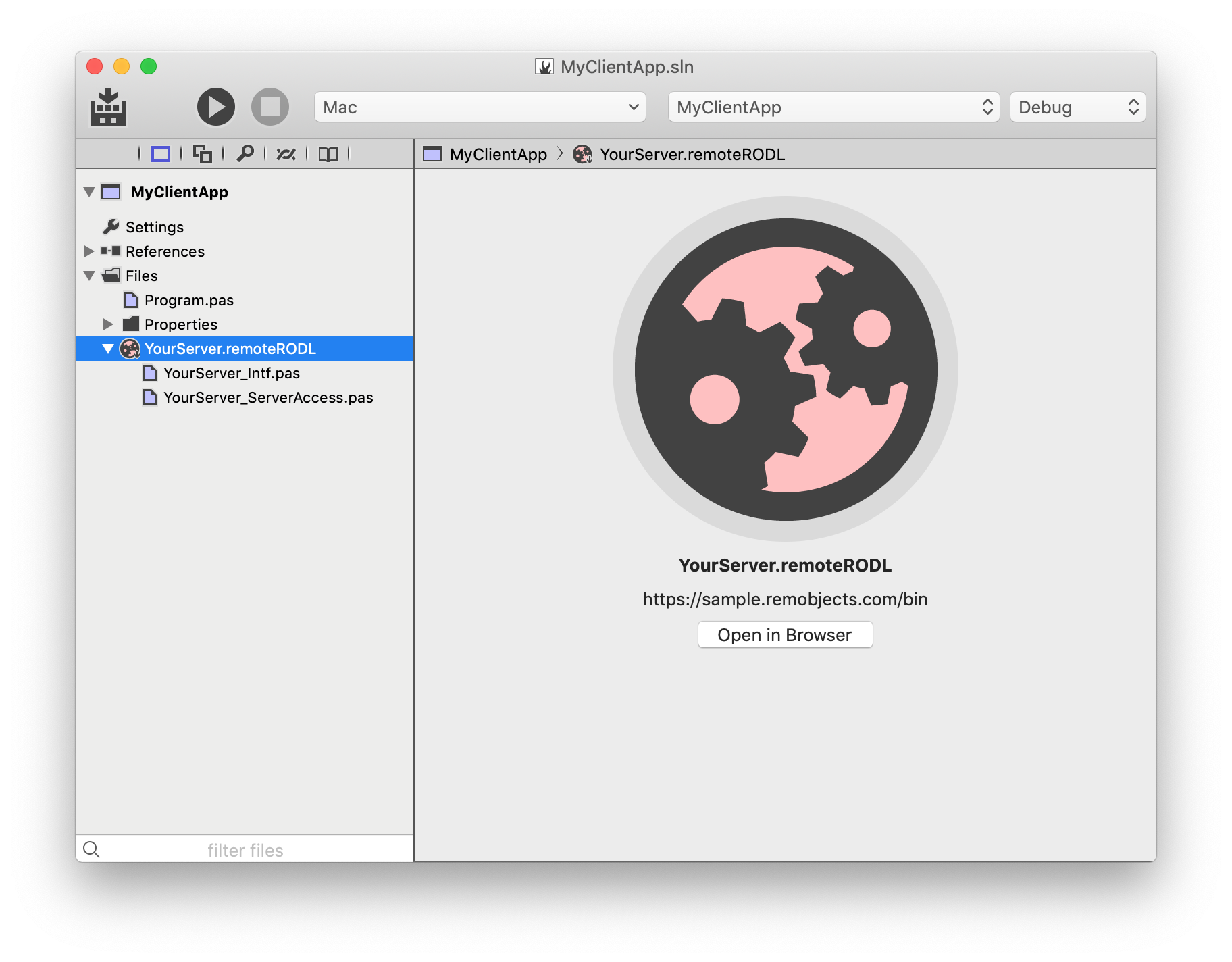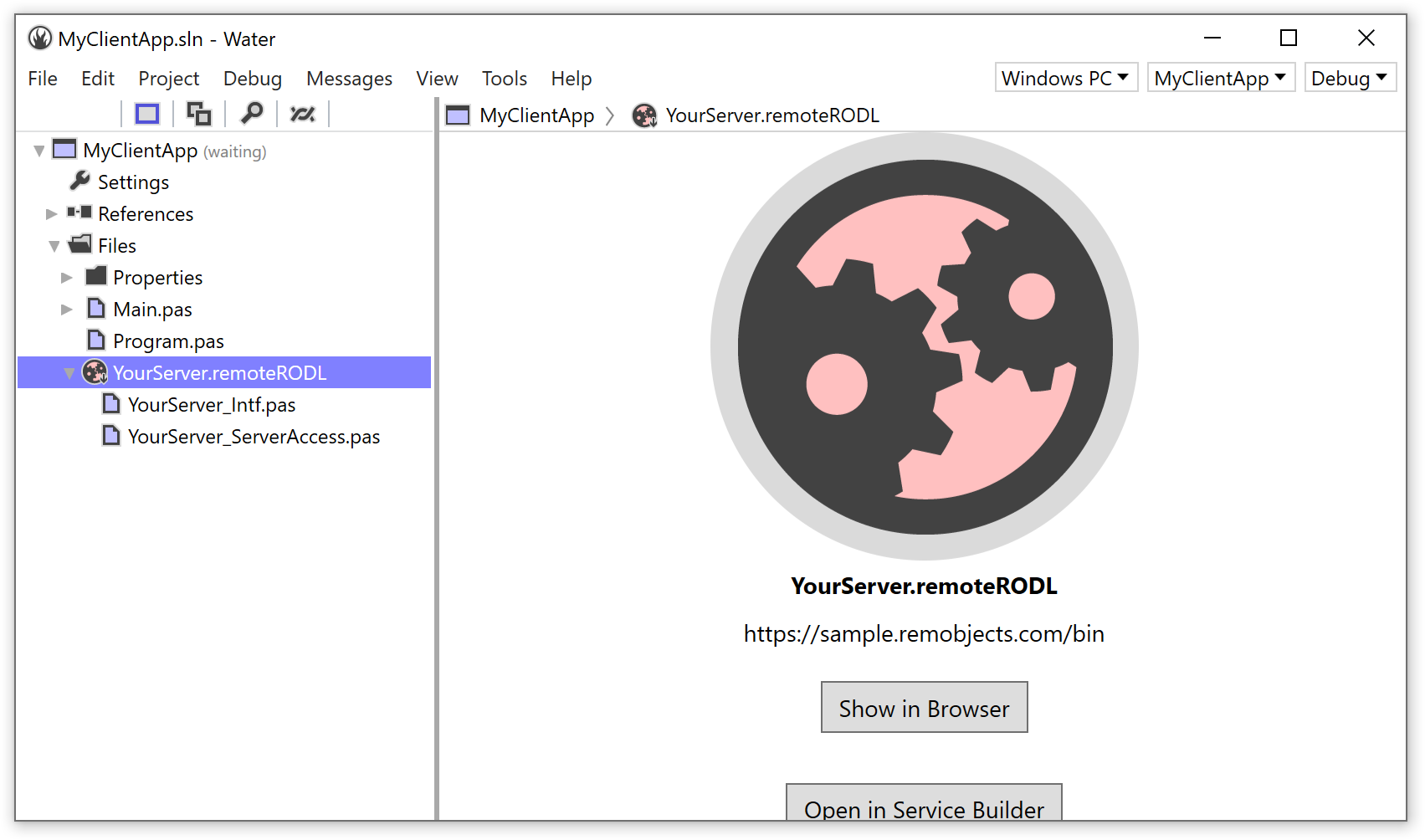Connecting to a Remoting SDK Server
Fire and Water make it really easy to turn any existing project into a Remoting SDK client and have it talk to your Server. Simply select "Connect to Remoting SDK Server..." from the "Tools" menu:


This option is available for projects created in any of the four supported languages (Oxygene, C#, Swift and Java) and on all three platforms supported by both Elements and Remoting SDK (.NET, Cocoa and Java).
Note: Fire includes trial binaries of Remoting SDK for all three platforms. If you do not have a full version of RO installed, the trial version will be used, and invoking the wizard starts your 30-day trial period. See also Installing Remoting SDK in Fire.
Selecting it will bring up this simple dialog, where you can specify the URL of your service (complete with port and path to RODL, so commonly that will end in :8099/bin) or alternatively browse for a local .RODL file on disk:


Enter your server's address and click "OK", and the IDE will automatically retrieve the RODL, process it, and generate a handful of new files for your project, all using your server's name as the base name:


The three files are:
- a
.remoteRODLfile - an
_Intffile generated in your project's default language - a
_ServerAccesssource file
You will notice that the IDE conveniently nests these three files together (automatically by filename), keeping everything that connects your app to your server in one place.
The YourServer.remoteRODL File is a small XML file that serves as the link between your project and the remote server, for this conversion and for future updates. Essentially, it just contains the URL of your server (or of the local .RODL file, if you selected one), and is provided for easy access to working with the server from the IDE. For example, you can update your code to changes in the server via this file, as explained in the Working with .remoteRODL Files topic.
The YourServer_Intf source file contains code generated by Remoting SDK to let you interact with the server. This includes interfaces/protocols for all the Remote Services exposed by your server, as well as any helper types these services use, such as custom enums or structs. You should not touch the code in this file, as it will be re-generated (thus losing any changes you make to it) when you update it to changes on the server. You can read more about _Intf files here.
Finally, the YourServer_ServerAccess source file contains a small helper class that provides a convenient starting point for encapsulating the access to your server from within your client app. Once created, this file becomes "yours", and you will most likely expand it to expose functionality more specific to your concrete server.
The ServerAccess class is merely a suggestion and an assistance to get you started, you can feel free to simply remove the file from your project if you want to structure your server access differently within the client app.
The ServerAccess Class
Let's have a closer look at what's inside the ServerAccess class.
This class will differ sightly between the platforms, in order to best fit in with the design patterns and paradigms that make sense on .NET vs. Cocoa vs. Java vs. Delphi. But the principle is the same: It's a singleton class with a single instance, accessible via a static Instance or sharedInstance property. It encapsulates your server URL and all the Remoting SDK components needed for the communication, such as the Client Channel and Message instances.
For each service exposed by your remote server, ServerAccess exposes a public property that gives you easy access to a ready-to-use Proxy class for that service. So all you need to do to make remote calls is to access those properties and call your service methods on them.
If your server uses Authentication via a LoginService, ServerAccess will already have that hooked up, and include a stub where you can implement your actual login logic and connect it to any login UI, where needed.
Of course it is up to you to decide which aspects of the pre-generated ServerAccess fit your application's design and which need changing. For example, you might not want to expose all service proxies publicly, but instead encapsulate access to certain services with bespoke wrapper methods you add to ServerAccess yourself.